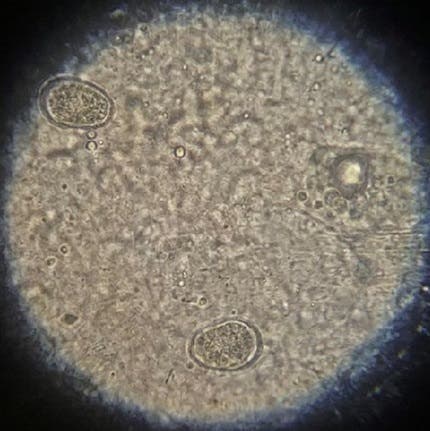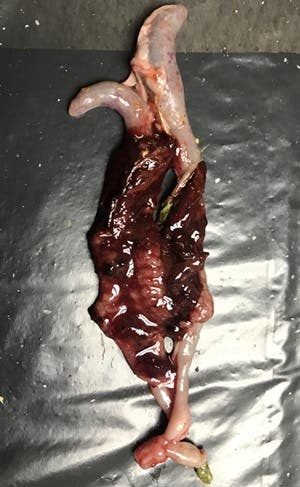What are the symptoms of coccidiosis in poultry?
Coccidiosis, is a common problem among poultry, and poses a significant risk to the health and productivity of broiler chickens.
It is one of the most costly diseases in the sector, and leads to severe economic losses, due to high mortality rates and decreased production efficiency.
The symptoms of coccidiosis can range from mild to severe, affecting bird welfare and broiler feed conversion ratios.
This blog aims to cover the various symptoms associated with coccidiosis in poultry, helping farmers recognise the early signs and take timely actions.
What is poultry coccidiosis and how does it impact broiler health?
Poultry coccidiosis is a highly contagious and potentially fatal disease affecting broilers, caused by the protozoan parasite, known as Eimeria.
These parasites specifically target the intestinal tract, with different species of Eimeria affecting different parts of the gut.
The disease is transmitted through the faecal-oral route, where broilers ingest infected material containing the parasite’s oocysts. These are highly resistant to environmental stresses and can survive for long periods outside the host.
Understanding the lifecycle of Eimeria is key to comprehending how coccidiosis develops in poultry and spreads within a broiler flock. Once ingested, the oocysts undergo a process called sporulation in the bird’s digestive system, releasing sporozoites that invade the intestinal lining cells.

Eimeria oocysts under the microscope
The impact of coccidiosis on broiler health can vary from mild to life-threatening. Here are some of the impacts:
- Gastrointestinal disease – The parasites damage the lining of the intestines, leading to inflammation and bleeding. This can result in watery and potentially bloody diarrhoea.
- Decreased feed intake and weight loss – Infected birds often show reduced appetite leading to weight loss and poor growth.
- Increased mortality – In severe cases of E. tenella, especially without timely intervention, coccidiosis can lead to high mortality rates within the flock.
Early signs of coccidiosis in poultry
Identifying coccidiosis in its early stages is crucial for effective management and control. The earlier the detection, the better the chances of reducing the severity of the outbreak and minimising its impact.
Early signs of coccidiosis in poultry that producers should watch out for include:
1. Bird behavioural changes in broilers
Behavioural changes are often the first indicators that something is amiss. Sometimes producers can detect these subtle signs before more obvious symptoms develop:
- Reduced feed intakes: Birds with the early stages of coccidiosis might start to eat less than usual. This change is often gradual and can be overlooked if not closely monitored.
- Lethargy: Affected broilers may appear unusually tired or show less interest in their surroundings. They might spend more time resting and less time feeding or interacting with the flock.
- Huddling or ruffled feathers: Birds often huddle and fluff up their feathers to conserve heat when they feel unwell. This behaviour might also be accompanied by a general dishevelled appearance.
2. Physical signs of coccidiosis
Alongside behavioural changes, physical signs can also hint at early coccidiosis:
- Pale comb and wattles: These are indicative of anaemia, which can be caused by blood loss associated with intestinal damage. The normally vibrant red colour may appear faded or whitish.
- Slight changes in droppings: Early changes in droppings might not be as dramatic as the bloody stools seen in advanced cases of E. tenella but look for any increase in the looseness of the droppings or subtle changes in colour.
3. Performance indicators of coccidiosis
Performance metrics in a broiler operation can also provide early warning signs:
- Inconsistencies in weight gain: If some birds are gaining weight significantly slower than others, it could be an early indicator of health issues like coccidiosis.
- Increased feed conversion ratio: An increase in broiler feed conversion ratio can suggest health problems, including parasitic infections.
Advanced symptoms and complications
When coccidiosis in poultry progresses beyond the early stages, the signs become more severe and harder to manage. Recognising these advanced symptoms is crucial for implementing urgent veterinary interventions and minimising flock mortality.
The major advanced signs of coccidiosis in poultry include:
1. Severe diarrhoea and bloody stools
One of the most alarming signs of advanced coccidiosis is the presence of severe diarrhoea, which may include significant amounts of blood when affected by E. tenella. This symptom indicates substantial damage to the intestinal lining, where blood vessels are eroded by parasitic activity. This condition not only leads to dehydration, but also severe nutrient loss.
2. High mortality rates in birds
As the disease progresses, the mortality rate within the flock can escalate quickly. If untreated, E. tenella can lead to a high percentage of fatalities, especially in younger or more vulnerable birds. Sudden increases in daily mortality rates are a clear signal that immediate action is required.
3. Marked weight loss in the birds
Infected birds may rapidly lose weight despite continued, albeit reduced, feed intakes. This weight loss is due to the inefficient absorption of nutrients caused by intestinal damage, compounded by the energy the birds expend fighting off the infection.

Blood in ceaca
4. Extreme lethargy and weakness in broilers
Advanced coccidiosis can leave broilers extremely lethargic; this may mean they are unable to stand or may lie down frequently.
This weakness affects the overall vitality of the bird and is generally a combination of:
- Anaemia
- Dehydration
- Systemic infection
5. Poor bird appearance
Broilers with advanced coccidiosis often look distinctly unhealthy. Signs include:
- Feather degradation: Feathers may appear ruffled, dirty, and poorly maintained due to the bird's reduced preening behaviour and general discomfort.
- Pale skin: The skin may turn pale, indicating poor circulation and advanced anaemia.
Elanco UK AH Limited, Form 2, Bartley Way, Bartley Wood Business Park, Hook RG27 9XA. Telephone: 01256 353131. Email: elancouk@elanco.com
Maxiban, Monteban, Elanco and the diagonal bar logo are trademarks of Elanco or its affiliates. © 2024 Elanco or its affiliates. Date of preparation:05/2024